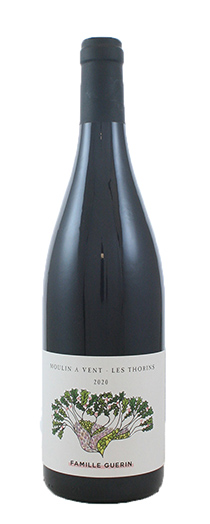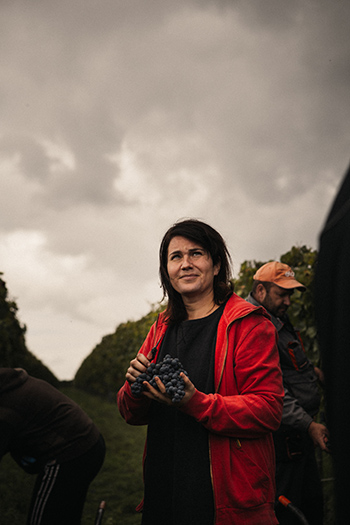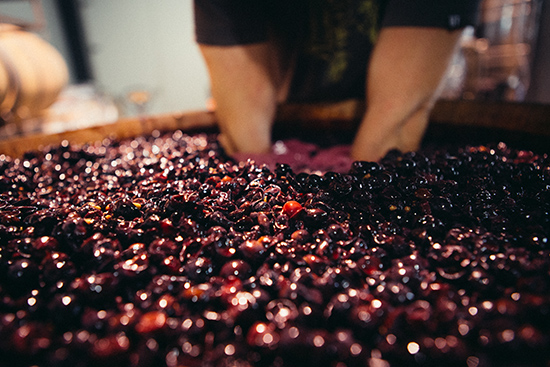Elisa Guerin, Domaine du Moulin d’Eole, Moulin-à-Vent, Beaujolais

After a spring where we almost had frost again at the beginning of April and a summer with worrying heat peaks, the rain waited all summer and only arrived on August 15th. These 25 mm saved the vintage and unlocked the ripening process. The grapes were able to take advantage of this rain to swell and finish their maturity. The work undertaken since 2019 on the restoration of our soils and their microbial life has, according to our observations, had a very strong effect on the resistance of our vines to drought. Thanks to work on the height of the foliage and the choice not to trim this year to avoid sunburn, at harvest time our grapes are beautiful and firm.
Satisfied with our yields and the quality of the harvest, we started the vinification with the will to preserve the fruit, not to push the extractions because the vintage looks powerful and hot. The cold vinification of whole bunches with very little mechanical intervention (pumping over, crushing) in order to find the finesse of the vintage is going particularly well. Here again, the work done in the vineyard over the last few years is certainly not to blame.
The indigenous yeasts have worked well and the fermentations have taken time but have all come to an end. The wines are now resting in their concrete and barrel containers throughout the winter and a little longer for some. Good news, this year the volumes are good and we will be able to have more volume than in 2021. In particular for the Beaujolais Villages which will be available in March 2023.
Some news, at the estate, the Chiroubles vineyard is now ploughed by horse and we have planted trees that attract birds to develop biodiversity. We are going to replant a new plot of chiroubles in 2023 after 3 years of fallow and a year planted with sorghum to bring carbon to the soil and recreate microbial life. On this new plantation, we will test a fermented forest litter juice (an agroecology technique invented in Cuba during the embargo) with the aim of boosting the life of the mushrooms.
Benjamin Anglade, Mas de Daumas Gassac, Languedoc
2022 was the longest harvest ever, as we had to wait for the perfect ripening of the Cabernet Sauvignon. The storm on August 15th was a life saver, in term of quality and quantity, so we are extremely happy and very exhausted.
My harvest feedback is that 2022 is a technical vintage where audacity will pay off in terms of soil expression through the grape varieties in question. The big challenge was to pick the red grapes after the end of August rains because once there is direct water absorption by the skin.
This allows:
– a slowed down wilting phase
– the cell membrane is healthy & intact
– for a smooth and efficient extraction in infusion at key periods
Today, at Gassac, all the malos are engaged and the juices are dense and deep.
Mas de Daumas Gassac red 2022 tanks (24 grape varieties) have generous tannins in the attack and then behind an energetic and deep tracer well in the profile of our soils style. This vintage has just the right amount of acidity to balance the mouth. Mouth in unison, intense, multidimensional, on the acidulous fruits.
No added sulphites and 0.18 volatile. All perfect.
Mas de Daumas Gassac white 2022 tanks reflect all the codes of the 20 grape varieties without distinguishing one from the other. 2022 white is spherical, deep and the tension of the finish brings the savoury and salivating dimension. The complexity is already doubled by a generously melted mid-palate and revived in the final with an iodized fruit ornament.
Both are very, very promising!
Judith Beck, Burgenland, Austria
The 2022 vintage was quite a challenging one for us. Both winter and spring were extremely dry. We had a relatively late budbreak followed by a very early flowering. Around the time of flowering there was finally the longed-for rainfall, but this also meant very high mildew pressure in this sensitive phase. The summer was hot and exceptionally dry, which resulted in drought stress and weak growth with the younger plants. We worked with herbal infusions and BD preparations a lot to support the vines. End of August we had a little rain which accelerated the ripening of the grapes enormously.
We started picking on the 25th of August. First we harvested the grapes for Pet Nat (Pinot Noir, Weissburgunder, St. Laurent) and the white grapes from younger vines.
I saw a danger of ending up with very low acidities, that’s why we continued with picking most of the whites then. The wines are showing well, with pronounced fruit and good texture.
After the whites, we could focus on Pinot Noir, St. Laurent and Zweigelt. Picking was very fast this year, because all the grapes were perfectly healthy. Only with the Zweigelt there were some shrivelled grapes because of the heat. We finished our harvest days at 2pm at the latest because of the hot weather during the first half of September.
Finally, temperatures went down and Welschriesling and Blaufränkisch arrived perfectly cool at the cellar. Both grape varieties show great quality this year. Those two seem to be the ones with the best ability to deal with the climate change issues that we are facing.
It is amazing to see how well all the natural fermentations are going in spite of the water stress. We finished harvest with some beautiful Blaufränkisch on 22 September after a period of 4 weeks. The good results we now have in the cellar compensate for all the efforts of the summer.
Primoz Lavrencic, Burja, Vipava Valley, Slovenia
In Slovenia, like in the rest of Europe the summer did not promise the best, due to the drought and high temperatures. However, the vines recovered after the rain in the last week of August, it was the help at the last moment! The harvest started at 27 of August with the Pinot Noir and finished at 28 of September with the Schioppettino. The weather was often unfavorable during this month of harvest due to three heavy rains, but there was no direct damage on the grapes, probably because the season was almost disease-free (lack of moisture). Quantitatively, the year 2022 was average, the amount of Pinot Noir and Reddo slightly above average, Malvasia slightly below average, everything else within the expected quantitative limits. The juices are extremely fruity; the alcohol levels are a little lower than in previous years. The musts are currently very harmonious.
*
Interested in finding out more about the wines of producers mentioned here? Contact us directly:
shop@lescaves.co.uk | sales@lescaves.co.uk | 01483 538820






